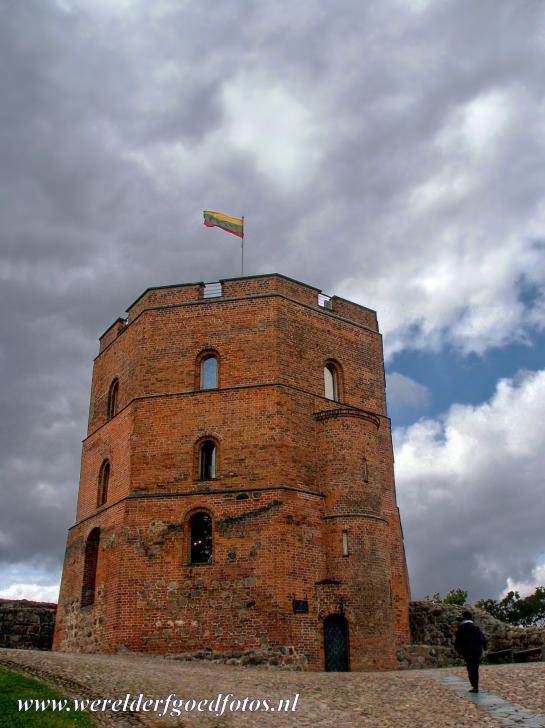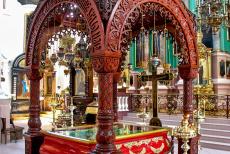Vilnius Historic Centre: Vilnius is the capital city of Lithuania. The Gediminas' Tower is the only remaining part of the Upper Castle of Vilnius. Vilnius always was a multi-religious city, there are several churches of 9 different faiths. The Cathedral of Vilnius dates from around 1419 and has eleven chapels. The Chapel of St. Casimir is the most important and most beautiful chapel of the Cathedral of Vilnius, the chapel was built in 1636 to house the remains of St. Casimir, the patron saint of Lithuania. The 57 metres high freestanding bell tower of Vilnius Cathedral was once part of one of the gates in the defensive wall of Vilnius. The Aušros Vartai (Gates of Dawn) is the only remaining city gate of Vilnius, the Aušros Vartai houses a tiny chapel with the icon of the Blessed Virgin Mary Mother of Mercy, one of the most sacred icons in Europe. The Vilnius University was founded in 1571. Inside, the walls and vaulted ceilings of the Vilnius University are decorated with colourful wall paintings. The former KGB headquarters and KGB prison, a symbol of Soviet occupation, is situated just outside Vilnius Historic Centre. Nowadays, it houses the Museum of Genocide Victims. The Baltic Way was a human chain linking the three Baltic States in their drive for freedom, it was a 600 km long chain from Tallinn to Vilnius, crossing Riga, the Baltic Way was inscribed on the UNESCO Memory of the World Register. Vilnius Historic Centre was declared a UNESCO World Heritage in 1994.
www.werelderfgoedfotos.nl © Copyright World Heritage Photos

Vilnius Historic Centre: The Gediminas' Tower is the only remaining part of the Upper Castle of Vilnius. The Upper Castle was completed in 1409. The Gediminas' Tower was restored in 1930, the top of the tower offers beautiful views of Vilnius, the town is situated at the confluence of the Vilnia and Neris rivers. The Gediminas' Tower is an important historic symbol of the city of Vilnius and Lithuania. Vilnius Historic Centre was declared a UNESCO World Heritage in 1994.

Vilnius Historic Centre: The Gediminas' Tower is the only remaining part of the Upper Castle of Vilnius. The Upper Castle was completed in 1409. The Gediminas' Tower was restored in 1930, the top of the tower offers beautiful views of Vilnius, the town is situated at the confluence of the Vilnia and Neris rivers. The Gediminas' Tower is an important historic symbol of the city of Vilnius and Lithuania. Vilnius Historic Centre was declared a UNESCO World Heritage in 1994.

Vilnius Historic Centre: The St. Casimir's Chapel, the most important chapel of Vilnius Cathedral. The St. Casimir's Chapel was built in 1636 to house the remains of St. Casimir (1458-1484), the patron saint of Lithuania, the chapel is a national treasure of Lithuania. Vilnius Cathedral dates from around 1419, it has eleven chapels. The freestanding bell tower is 57 metres high and was once part of one of the city gates in the defensive wall of Vilnius.

Vilnius Historic Centre: The Bernardine Church and monastery dates from the beginning of the 16th century, the church once was part of the defensive walls of Vilnius, the church was used in the defence of Vilnius and has a number of loopholes in the northern façade. During the Soviet occupation, the church was closed down and used as a warehouse and a school. Vilnius always was a multi-religious city, there are several churches of nine different faiths.

\Vilnius Historic Centre: The St. Casimir's Church was built between 1604 and 1635 and is one of the first Baroque churches in Vilnius. The Roman Catholic church was destroyed three times and rebuilt three times. In 1812, the French army turned the St. Casimir's Church into a granary and in 1839, the Russians turned it into an Orthodox church. The church was returned to the Roman Catholic Community in Vilnius in 1988 and fully restored in 1991.

Vilnius Historic Centre: The Three Crosses on the Hill of Three Crosses, also known as Bleak Hill. The Three Crosses is a prominent monument in Vilnius. According to a legend, seven Franciscan friars were beheaded on Bleak Hill in the 14th century. The first wooden crosses were erected in the 17th century, they were replaced by concrete crosses in 1916. The Three Crosses on Bleak Hill became a symbol of Vilnius.

Vilnius Historic Centre: The St. John's Church was built between 1386 and 1426, the bell tower of the church has a height of 68 metres and is the highest building in the city. The front façade was rebuilt in the Baroque style in the 18th century. The St. John's Church is part of Vilnius University since 1963, the church is located in the Grand Courtyard of the university. Vilnius University was founded in 1571.

Vilnius Historic Centre: The interior of Vilnius University is decorated with murals. The interior of the Linguistic Institute is decorated with colourful murals depicting the Seasons of the Year and Baltic mythological motifs, painted between 1976 and 1984. It is only possible to visit the Vilnius University on a guided tour. The university is situated in the historic centre of Vilnius.

Vilnius Historic Centre: The wall paintings in the Baranauskas Hall of the Vilnius University. The Baranauskas Hall is dedicated to the bishop and poet Antanas Baranauskas and other famous Lithuanian people. The bronze doors at the University Library are dedicated to the first printed book in the Lithuanian language in 1547. The library was founded by the Jesuits, it is nine years older than the university. The library holds over five million documents.

Vilnius Historic Centre: The Aula of Vilnius University is situated in the Grand Courtyard. Vilnius University was founded in 1579. It is the oldest university in the Baltic States and also one of the oldest in the north of Europe, the historic campus of the university consists of sixteen buildings and thirteen courtyards. Vilnius Historic Centre gained the status as a UNESCO World Heritage in 1994.

Vilnius Historic Centre: The Aušros Vartai, Our Lady of the Gate of Dawn, is the only remaining city gate. The Aušros Vartai was built in the period 1503-1522 and was part of the fortifications of Vilnius. Every day, pilgrims are waiting to enter the Gate of Dawn and the small chapel with the famous icon the Blessed Virgin, Mary Mother of Mercy. In the 16th century, the city gates of Vilnius contained religious objects intended to guard the city.

Vilnius Historic Centre: The Chapel of Our Lady of the Gate of Dawn houses the famous icon of the Blessed Virgin, Mary Mother of Mercy, one of the most sacred icons in Europe. The chapel is a major pilgrimage destination in Vilnius. The walls of the small chapel are adorned with votive offerings, the icon is believed to have miraculous and healing powers. Vilnius Historic Centre was inscribed on the UNESCO World HeritageList in 1994.

Vilnius Historic Centre: The Roman Catholic St. Anne's Church was built between 1495 and 1500. The façade is a masterpiece of the Flamboyant Gothic style. Some experts believe that patterns of the Columns of Gediminas, one of the earliest symbols of Lithuania, have been incorporated into the red brickwork façade, the freestanding neo-Gothic bell tower was built in the 1870s. In 1812, during the French invasion of Lithuania, the church was visited by Emperor Napoleon.

Vilnius Historic Centre: The Orthodox Church of the Holy Spirit is a pilgrimage destination, the church was built between 1749 and 1753. The interior dates back to the 18th century. It is the main Orthodox Church in Lithuania. The Friary of the Holy Spirit and convent of the Holy Mary Magdalene are situated next to the church. The monasteries are still inhabited by monks and nuns. Even during the Soviet period, the monasteries remained open.

Vilnius Historic Centre: The Orthodox Church of the Holy Spirit houses the reliquary with the relics of the Saints Jonas, Eustachius and Antanas. During the reign of Algirdas, the pagan Grand Duke of Lithuania, the young men were arrested for preaching in public, martyred and executed in 1347. During Christmas, the remains are dressed in white, in black during Lent, in red during the remainder of the year. On June 26th, they are displayed entirely naked.

ilnius Historic Centre: The wall outside the Museum of Genocide Victims is engraved with the names of KGB victims, a remembrance of those who were killed inside the building during the Soviet occupation. The Museum of Genocide Victims is situated in the former KGB prison and headquarters. The former KGB building is a symbol of the years of the Soviet occupation. The museum is located just outside Vilnius Historic Centre.

Vilnius: The Museum of Genocide Victims, known as the KGB Museum, the museum is situated in the former KGB headquarters and prison. The KGB prison has been kept in the original state. The KGB museum is divided into three parts, the two upper floors houses an exhibition about the Lithuanian resistance against the Soviet occupation, the basement houses the KGB prison, the cells, the torture rooms and execution chamber.

Vilnius: One of the historic wooden houses in Žvėrynas, situated just outside the historic centre of Vilnius. Žvėrynas is one of the older and smaller neighbourhoods of Vilnius, well known for its wooden houses. The Šnipiškės neighbourhood is also famous for its wooden houses. Žvėrynas and Šnipiškės are situated on the banks of the Neris River. The wooden houses were built in the 19th and 20th centuries.
